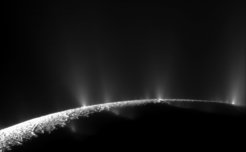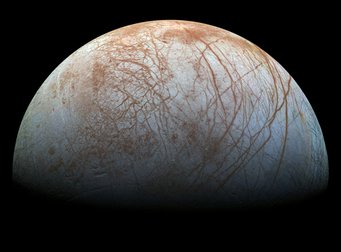Jupiter’s moon Europa:
New evidence of watery plumes
New simulations indicate that Jupiter's fourth largest moon ejects water from its subsurface ocean into space.
During a fly-by of Jupiter’s moon Europa twenty years ago, NASA’s space probe Galileo may have witnessed a plume of water. A group of scientists including researchers from the Max Planck Institute for Solar System Research (MPS) in Germany have now found new evidence of this event. In computer simulations they strove to reproduce the data gathered by the onboard particle detector that was developed and built at MPS and in the USA. This was only successful under the assumption that a water plume was involved. With its crust of frozen water and subsurface ocean, Europa has environmental conditions that could be favorable for simple forms of life. Water plumes would offer future missions to Jupiter the possibility of coming into direct contact with the moon’s water reservoir.

A layered inner structure including a liquid iron core, a thin oxygen-rich atmosphere, an induced magnetic field - Jupiter's fourth largest moon, Europa, has greater resemblance with a planet than with a primitive moon. Another special feature: the up to 18-kilometer thick outer crust of frozen water covers a subsurface ocean of water. With the new calculations by a group of researchers led by the European Space Agency (ESA) and MPS, there is now increasing evidence that the Jovian moon releases this water into space, at least occasionally, in cryovolcanic eruptions referred to as plumes. Saturn’s moon Enceladus is known to display similar behavior. During NASA’s Cassini mission, the onboard cameras took spectacular images of its plumes.
Comparable and conclusive proof that also Europa spouts water into space is still missing. "However, various theories, models, and sporadic observations suggest that Europa, too, can exhibit plumes”, says MPS scientist Dr. Elias Roussos. In recent years, researchers from several institutes in Europe and the USA have independently found evidence of a specific plume. Some of these groups evaluated data from the magnetometer on board NASA’s Galileo spacecraft, which from 1995 onwards spent eight years exploring the Jovian system. During a fly-by of Europa in 2000, the measured data showed deviations in Jupiter’s magnetic field near the moon. These could be due to a plume that occurred at the same time.
ESA scientist Dr. Hans Huybrighs and his colleagues also revisited data from the flyby in 2000 – however this time, they took another look at measurements performed by the Energetic Particles Detector (EPD). This instrument was developed and built at the Applied Physics Laboratory of Johns Hopkins University (USA) and at MPS. Among other things, EPD recorded the distribution of high-energy protons trapped in Jupiter's magnetic field.
"Jupiter's magnetic field is up to twenty times stronger than Earth’s and extends several million kilometers into space," MPS researcher Dr. Norbert Krupp describes the conditions within the Jovian system. Europa orbits Jupiter within this enormous magnetic protective shield. During the flyby, EPD recorded significantly fewer protons near the moon than expected. Previously, researchers had assumed the moon itself to have obstructed the detector's view.

However, the current results indicate another cause. In elaborate computer simulations, scientists led by ESA and MPS modelled the movements of high-energy protons during the flyby attempting to reproduce the measurement data from EPD. This was only successful under the assumption that a plume had influenced Europa’s environment. When high-energy protons collide with uncharged particles from the moon’s atmosphere or plume, they incorporate electrons from them thus becoming uncharged particles themselves. "This means they are no longer trapped in Jupiter's magnetic field and can leave the system at high speed," explains first author Dr. Hans Huybrighs from ESA.
For future missions to the Jovian system, Europa's plumes would offer the possibility of coming into direct contact with the moon's subsurface water reservoir and characterizing it. In 2022, ESA's JUICE mission (Jupiter Icy Moon Explorer) will embark on its its journey. MPS will contribute the Submillimeter Wave Instrument (SWI) and the Jupiter Electron and Ion Spectrometer (JEI), one of six sensors from the Particle Environment Package (PEP), to this endeavor. NASA is also preparing the Europa-Clipper mission, which is to be launched in 2023 to the Jovian system. MPS is involved in the mission’s science team.













